Introduction
Technical documentation serves as the blueprint for product understanding and utilization, going beyond mere instructions to streamline workflows and enhance user experiences. In this article, we explore the importance of documentation review and its impact on operational efficiency, team productivity, and user satisfaction. We delve into real-world case studies, highlighting how companies like Dectar have transformed their documentation processes to cater to diverse audiences and reduce support team workload.
We also discuss the steps involved in the documentation review process, the different types of reviews, and the tools and techniques that can enhance the effectiveness of the review process. Additionally, we provide best practices for conducting effective documentation reviews and address common challenges faced during the review process. By emphasizing the value of clear and comprehensive documentation, this article aims to underscore the significance of documentation review in achieving maximum efficiency and productivity.
What is Documentation Review?
Technical documentation is more than just a set of instructions; it's the blueprint for product understanding and utilization. Take Doctor, a developer of cybersecurity products, as a case in point. Initially, their support team juggled documentation with customer service, resulting in inefficient overnight efforts to produce release notes.
Recognizing the need for change, Director appointed a dedicated documentation owner, aiming to streamline the support team's workload and improve multi-language content delivery for their diverse clientele.
Furthermore, fieldwork parallels such as those in California's wildfire risk management, where a few companies oversee vast territories, mirror the far-reaching impact of clear, efficient documentation in tech. For Dectar, it meant meticulously testing products to capture step-by-step processes, thereby tailoring the content to the technical expertise of system administrators - their primary audience.
The recent 2022 practice brief underscores the critical nature of thorough documentation. Spanning 20 pages, it highlights updated guidelines for healthcare professionals, emphasizing the use of clear, compliant queries backed by clinical evidence - a standard that applies across sectors, including tech.
When it comes to code documentation, the README file is paramount, serving as an introductory handshake to the project. It encapsulates the project overview, effectively communicating purpose and scope to developers, users, and stakeholders alike. A project's evolution, like the one that shifted from a creator-focused platform to a business-centric tool, necessitates a pause for documentation reassessment to ensure clarity for all users.
The essence of documentation is captured in the words of an open-source advocate: it's the friendly guide that bridges code and community. It's about knowing your audience, whether they're project veterans, end-users, or complete novices, and providing a comprehensive, accessible overview.
And let's not forget the importance of peer review in documentation. Just as researchers rely on skilled peers to validate their work, so too does technical documentation benefit from critical evaluation to ensure accuracy, clarity, and usefulness. In the end, the goal is to create documentation that not only informs but also enhances the user experience and contributes to the product's overall success.
Importance of Documentation Review
Comprehensive documentation is the linchpin of successful technical projects, serving as a clear map of the software's design, architecture, and functionalities. It goes beyond aiding developers; it is equally crucial for end-users and stakeholders to effectively navigate and utilize the software. A case in point is the documentation efforts for cybersecurity products by Sector.
Originally, their Support Team was overburdened with producing documentation, sometimes working through the night to release notes synchronously with software updates. By designating a dedicated documentation owner, Decatur aimed to alleviate the Support Team's workload, illustrating the pivotal role documentation plays in operational efficiency and team productivity.
A compelling example is the documentation transformation for a platform that evolved from a creative map-based experience to a robust event and business-focused tool. The project's intricate features necessitated a pause in development to create accessible documentation for both developers and platform administrators. This shift underscores the significance of understanding and addressing the needs of different documentation audiences, such as system administrators or newcomers unfamiliar with the project's scope.
The essence of impactful documentation is captured in the words of a seasoned technical writer: 'The first step is to define an initial set of success criteria. These should be comprehensive, minimal, written, and falsifiable.' Aligning with this perspective, software documentation must serve as a single source of truth that is both comprehensive and concise, ensuring clarity for all parties involved.
This approach resonates with the latest industry standards, such as the IEC 81001-5-1, which sets forth technical requirements for medical device manufacturers to mitigate cybersecurity risks.
In essence, quality documentation serves as the foundation for any software project. Without it, projects risk falling into disarray. It is not merely a static resource but a dynamic tool that evolves with the project, reflecting the ongoing commitment to clarity, user understanding, and operational excellence.
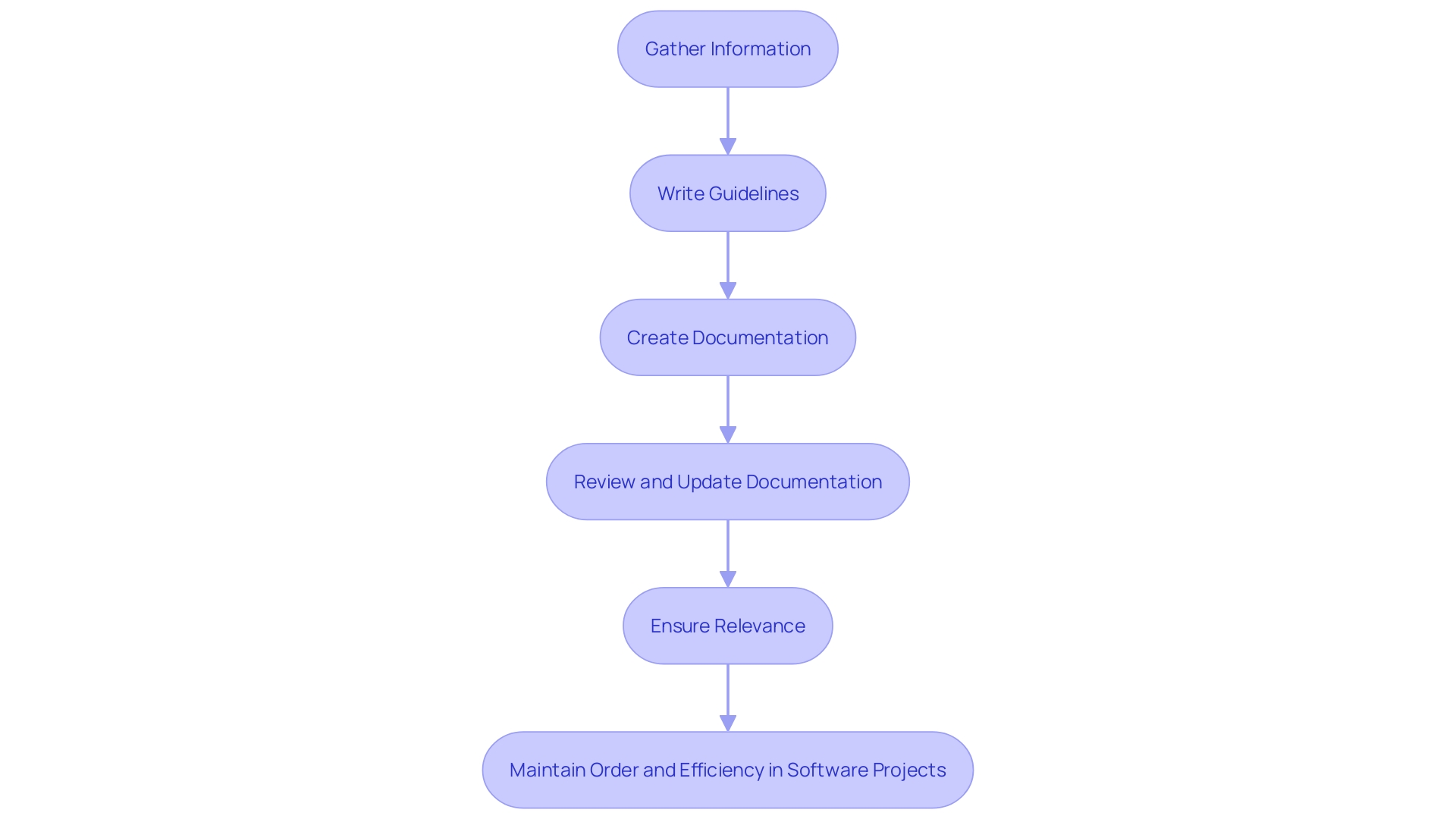
Steps Involved in the Documentation Review Process
- For a constructive review of technical documentation, start by delineating the review objectives to establish a clear focus. Scrutinize the documentation for accuracy, relevance, and areas necessitating enhancement, keeping in mind the evolving nature of the project and its audience.
- Assemble all pertinent materials, including manuals and technical specs, to prepare for an exhaustive evaluation. This ensures reviewers are well-equipped with the knowledge and resources necessary for a thorough analysis.
- Dive into the review with a meticulous examination of the documentation's precision, comprehensiveness, and intelligibility. Vigilantly identify discrepancies and improvement opportunities, meticulously recording observations.
- Facilitate an open dialogue among stakeholders—technical writers, developers, and managers—sharing insights and strategizing solutions collaboratively. The exchange of perspectives is crucial to refining documentation quality.
- Revise the documentation post-discussion, clarifying ambiguities and resolving issues to align with the initial review objectives. This iterative process is pivotal in honing the documentation to meet users' needs effectively.
- Undertake a final assessment to confirm all revisions are exact and the documentation is intuitive. Only after ensuring the thoroughness and clarity of the content should stakeholders give their seal of approval.
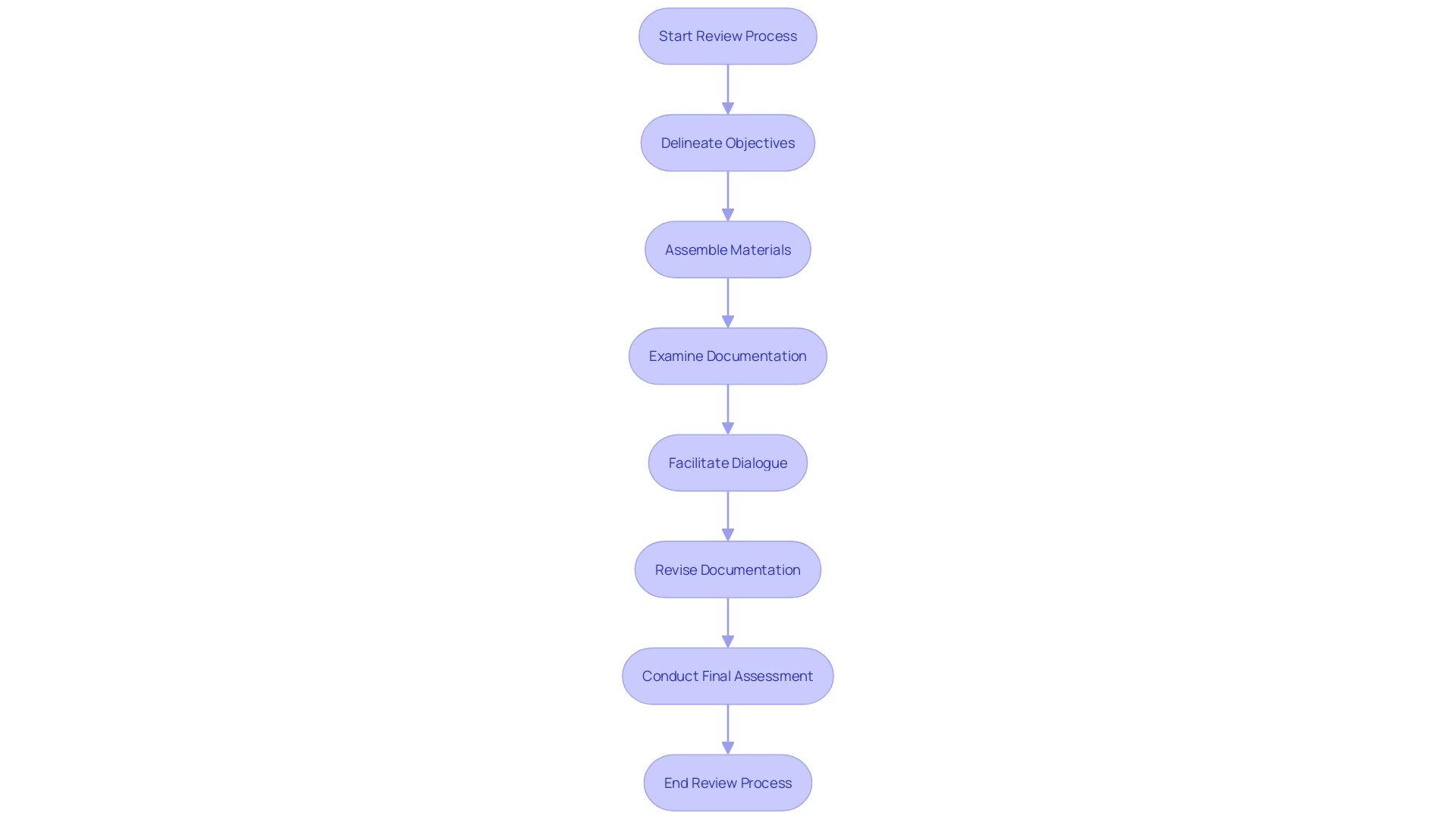
Types of Documentation Review
Technical documentation reviews serve multiple purposes and come in various forms, each targeting a specific aspect of the material to ensure its effectiveness and compliance. A Technical Accuracy Review examines the precision of the technical details provided, guaranteeing that the content is not only correct but also reflects the latest updates. This is akin to how safety standards are scrupulously applied to industries such as electrical utilities, where the risk of catastrophic wildfires demands the most current and meticulous safety measures.
Next, a Content Review delves into the documentation's clarity, structure, and thoroughness. Like the exhaustive research and interviews undertaken in extensive case studies, this review aims to polish the documentation to enhance its readability and make it more user-friendly.
The Usability Review is about the ease with which end-users can navigate and comprehend the documentation. It's a process similar to assessing the user experience in software applications, where the goal is to tailor the documentation to meet the specific needs of its audience, much like how a service's system architecture is made understandable through clear and detailed documentation.
Lastly, the Compliance Review verifies adherence to relevant industry standards, much like the legal reviews conducted for projects such as those by the Wikimedia Foundation, where compliance with specific terms and transparency is paramount. This type of review confirms that the documentation aligns with the necessary quality and safety benchmarks, reflecting the importance of accuracy and accountability in documentation, as seen in the meticulous approach to HCC coding reviews.
Through these various types of reviews, technical documentation becomes a reliable and authoritative resource that not only informs but also facilitates efficient and effective use of the software product it describes.
Tools and Techniques for Documentation Review
Technical documentation is vital for the successful utilization of any platform or product, as it provides clarity and guidance to developers and end-users alike. To enhance the documentation review process, consider these strategies:
-
Track Changes: Leverage word processors with 'Track Changes' functionality to allow real-time edits and comments, facilitating collaborative revisions and streamlined communication among reviewers.
-
Peer Review: Assemble a team of experts and stakeholders to assess the documentation. Their diverse expertise can pinpoint inaccuracies and offer insightful feedback, ensuring the material meets varied user needs.
-
Style Guides and Templates: Adopt standardized style guides and templates to maintain uniformity, making the documentation more professional and cohesive, which is crucial for complex projects with multiple features and updates.
-
Automated Testing: Use automated tools to scrutinize documentation for errors, inconsistencies, or formatting issues. Such tools expedite the identification and correction of common problems, saving valuable time.
For example, during the evolution of a platform originally designed for creators to develop map-based 'experiences,' the shift towards a focus on events and business necessitated a pause in development to overhaul the documentation. This ensured that it remained accessible and understandable to both developers and platform administrators, highlighting the importance of adaptability and clear documentation in the face of project growth.
In another instance, a cybersecurity firm, Dectar, faced documentation challenges that overburdened their Support Team. By dedicating an individual to oversee documentation, they aimed to alleviate the strain on the team and improve structured communication with stakeholders in multiple languages.
Furthermore, it's essential to test the product thoroughly to effectively document each step of the process. This hands-on approach allows technical writers to draft accurate documentation tailored to the intended audience, such as system administrators, who require detailed and technical explanations.
In the realm of technical writing, semantics plays a critical role. It delineates the structure of a document, distinguishing headings, body text, and narrative blocks, which is fundamental for content that integrates into efficient workflows. Likewise, a foundational understanding of engineering principles can greatly benefit technical writers, even those who come from non-technical backgrounds, by providing a deeper grasp of the products they are documenting.
Lastly, the application of machine learning techniques in software engineering, including documentation, is an emerging field of study. This approach leverages various ML methods to enhance areas such as software quality assurance and comprehension, representing the cutting-edge intersection of technology and documentation.
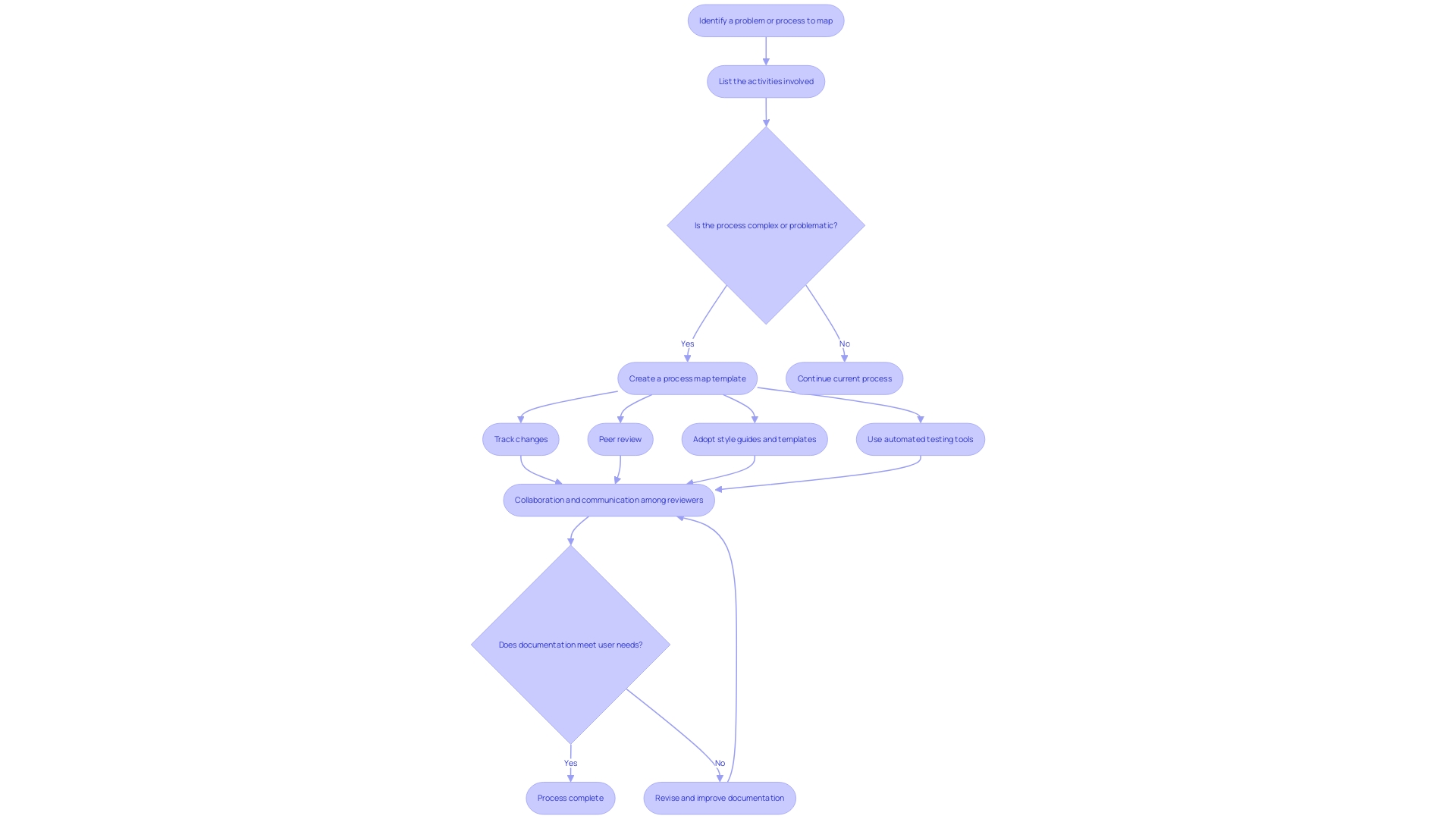
Best Practices for Effective Documentation Review
To streamline the documentation review process, adhere to the following strategies:
-
Establish Clear Evaluation Guidelines:
- Define concise criteria for assessing the documentation to guarantee uniformity and impartiality during reviews.
-
Involve Technical Experts:
- Include subject matter experts with comprehensive knowledge of the project's technical aspects to pinpoint inaccuracies or omissions.
-
Promote Team Collaboration:
- Cultivate an environment of open dialogue where feedback is exchanged constructively. Provide a platform for reviewers to propose improvements.
-
Record Review Outcomes:
- Keep a log of the findings and corrective measures to monitor the review's progress and confirm the resolution of all issues.
-
Embrace Ongoing Refinement:
- Regularly refine the documentation to mirror project updates. Continually solicit user and stakeholder feedback to elevate the quality of your documentation.
In a case where a financial services customer requested a design review for a MongoDB Atlas application, the review process was crucial in providing regional account managers with a comprehensive view of performance data, thereby avoiding lost time due to poor schema design. Similarly, in medical device regulation, professionals rely on thorough documentation reviews to navigate the complexities of global SaMD regulations, vital for the safety and efficacy of medical devices in international markets.
A sound documentation review is not just about identifying errors; it's a learning opportunity for developers to transition from legacy systems and improve software design, as seen in a case where developers were educated on optimizing schema for better performance. Moreover, advanced search features, access control, and integration with other tools are essential functionalities that benefit from meticulous documentation reviews as they directly impact user experience.
Statistics further highlight the critical nature of accurate documentation. For instance, a study revealed that 39-42% of actions in emergency scenarios were incorrectly or incompletely recorded when relying on written documentation, underscoring the value of video documentation for precise recording of events.
Overall, an effective documentation review process is integral to the success of any project, ensuring clarity, accuracy, and compliance, ultimately fostering a culture of continuous improvement.
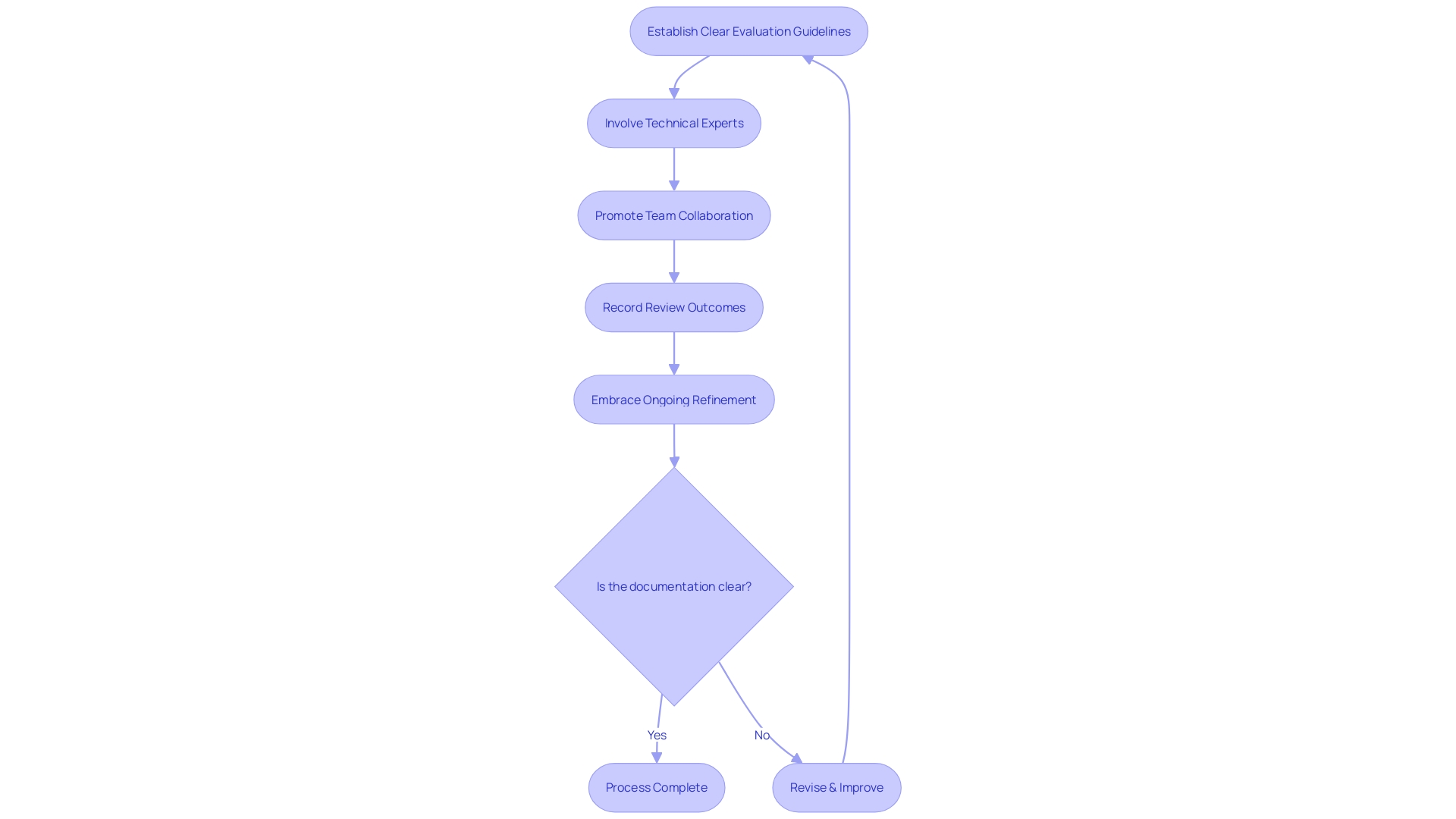
Common Challenges in Documentation Review and How to Overcome Them
Technical documentation is the cornerstone of efficient software development, providing essential information on design, architecture, and functionality to all stakeholders involved. With this in mind, let's tackle some common challenges faced during the review of such crucial documents.
-
When it comes to clarity in technical documentation, simplicity is key. To ensure that every reader, including those for whom English is a second language, can understand the content, it's crucial to use straightforward words and direct language. This not only helps in making the instructions clear but also addresses the need for clear definitions of new terms, helping to avoid confusion.
-
Reviewing technical documentation is time-intensive, but prioritizing is a practical solution. By focusing first on the most critical sections, reviewers can efficiently manage their time and resources. This methodical approach is supported by the fact that technical documentation serves as a roadmap for the development process; hence, prioritizing ensures that the most vital aspects of the software are understood and agreed upon early.
-
A common hurdle is resistance to feedback from technical writers. To counter this, fostering a collaborative environment where open communication is encouraged can be beneficial. Emphasizing the value of constructive feedback is essential, as it is a driving force for improving documentation quality. Remember, as one quote emphasizes, writing is a learned skill, and ongoing refinement is part of the process.
-
Scope creep can derail the documentation review process. To prevent this, defining the objectives and scope at the outset is crucial. Regular check-ins with stakeholders can help maintain focus and prevent the process from expanding beyond its original boundaries.
Each of these strategies aims to enhance the effectiveness of technical documentation, ensuring it acts as a clear guide for all involved in the software development lifecycle.
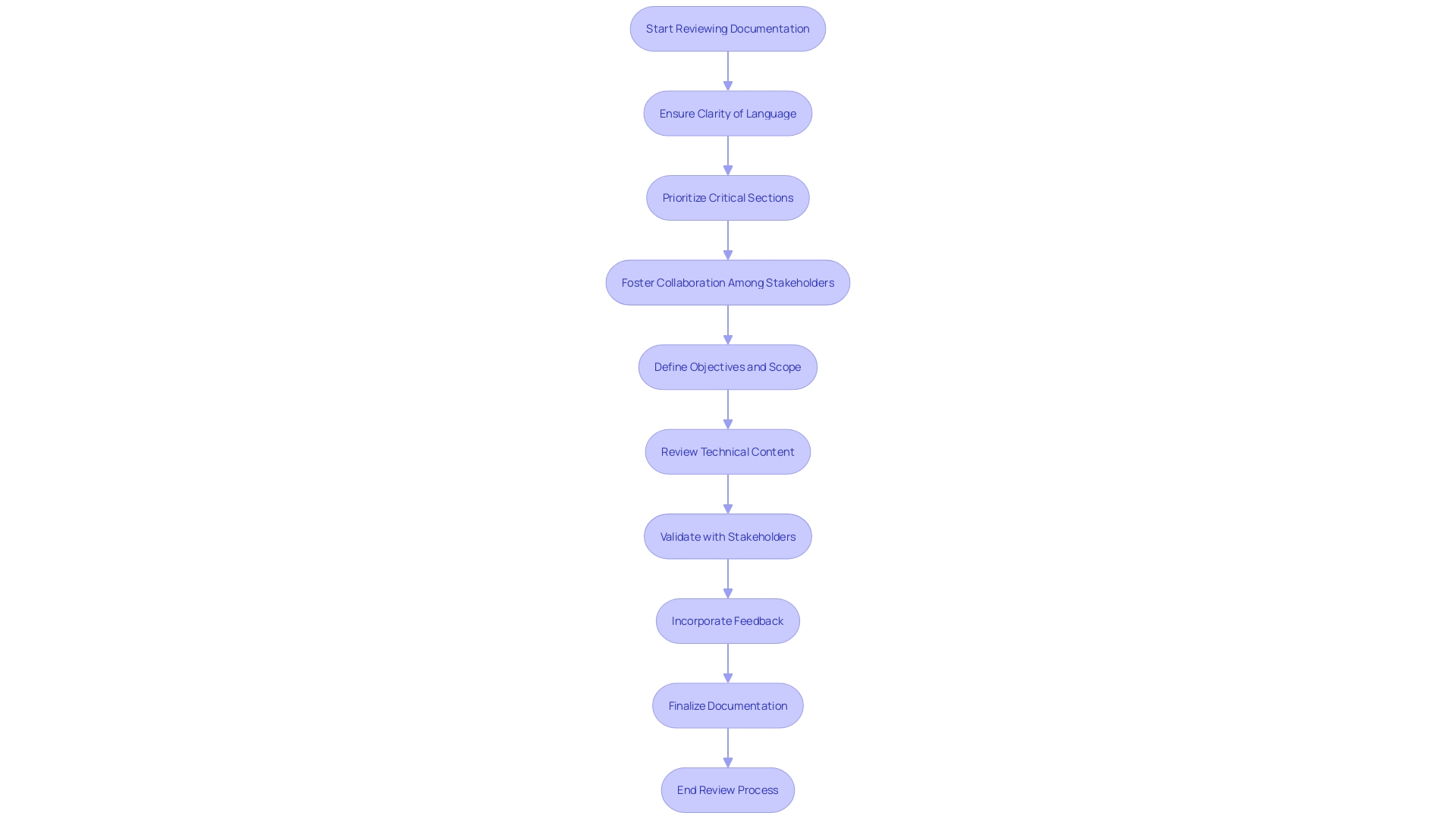
Case Studies or Examples of Successful Documentation Review
Effective documentation review has proven to be a cornerstone in enhancing product usability, compliance, and customer satisfaction. For example, Doctor, a cybersecurity firm, faced challenges with their documentation process, which was initially managed by their support team without a structured approach. They recognized the need for an owner of the documentation who could focus on reducing the support team's workload, especially during software release periods.
This strategic shift was aimed at streamlining processes and ensuring documentation was available in multiple languages, catering to a diverse audience.
Another instance highlighting the importance of documentation review is a major retail company's efforts to document their software and processes. They realized that testing the product is the initial and most crucial step, as it allows the technical writer to experience the process firsthand. This approach not only aids in creating step-by-step documentation but also helps in identifying the target audience's needs, such as middle system administrators who manage IT operations.
Moreover, the significance of documentation is echoed in the tech community, where publications like Top Tech Tidbits offer curated, high-quality content to keep readers informed about the latest trends. Similarly, in the healthcare sector, systems like PRISMA have been instrumental for clinics like Bright Future Pediatrics to access comprehensive medical records, exemplifying the broader applications of effective documentation practices.
These case studies underscore the value of meticulous documentation review, not just as a formality but as a strategic tool that can lead to a reduction in user support tickets, enhanced user experience, and adherence to industry regulations, thereby maintaining a company's trusted reputation.
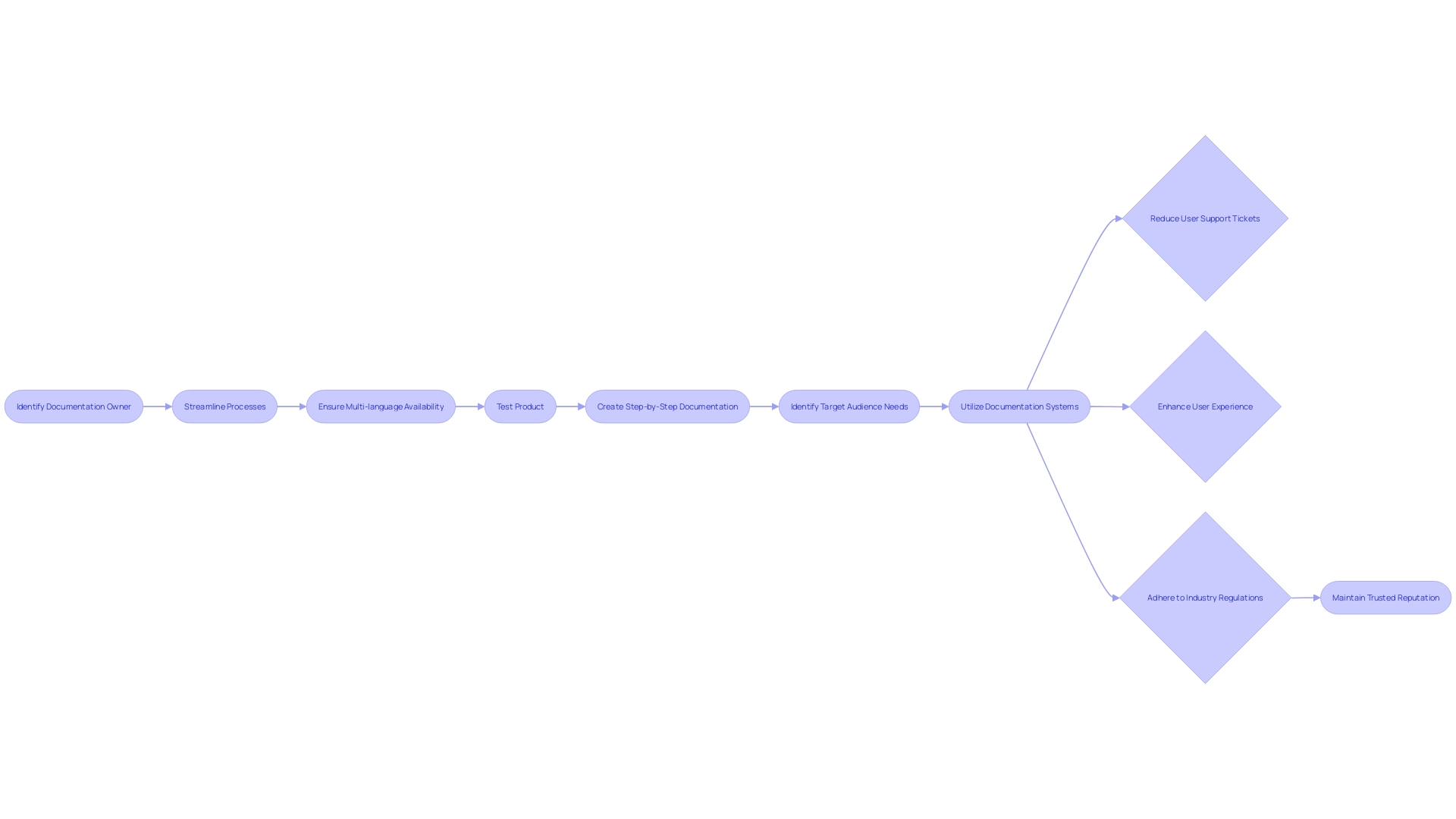
Additional Resources
For those looking to dive deeper into the art of documentation review, consider the following insights derived from real-world scenarios and expert advice. Take the example of Summer Health, which revolutionized pediatric care by enabling consultations via text, but faced the challenge of efficiently documenting visits for both doctors and parents. This highlights the importance of clear and concise medical notes that avoid unnecessary jargon and administrative burden.
Similarly, Somerset Academies of Texas experienced a transformation when they consolidated disparate software systems into a more integrated solution, thanks to the efforts of Austin Morgenroth, Director of Technology Services & Communications. This case underlines the significance of having streamlined, coherent documentation that supports an organization's growing and diverse needs.
When conducting a review, clarity is paramount. Avoid the pitfalls of recency bias by setting a clear scope for the review period, as evidenced by one manager's experience. This ensures that all team members are aligned and focused on relevant topics.
Moreover, embracing simplicity in language and structure can greatly enhance the reader's comprehension. The use of logical sequencing and inclusion of practical examples are key to maintaining an effortless flow of information. Advanced search features, permissions for different user access levels, and integration with other tools also play a crucial role in making documentation more user-friendly.
Collections data expertly points out the often 'invisible' labor involved in documenting and maintaining records, emphasizing the need for recognition and proper documentation. Another professional in the field stresses the importance of documentation in guiding users and developers, reiterating the need for clear and concise writing that focuses on the 'why' as much as the 'what.'
Statistics and studies bring attention to the critical role of semantics in documentation. Differentiating the main narrative from asides and understanding the parts of a document contribute to a streamlined workflow, making content accessible to all users. Additionally, while an engineering background is not a prerequisite for technical writing, a fundamental understanding of engineering principles can be beneficial.
In sum, these resources and anecdotes serve as a testament to the pivotal role of effective documentation reviews in enhancing understanding, improving processes, and supporting efficient communication within various professional domains.
Conclusion
Comprehensive technical documentation is essential for achieving efficiency and productivity. Through dedicated documentation review processes, companies like Dectar have transformed their operations, reducing support team workload and improving content delivery. The review process involves clear objectives, meticulous examinations, and revisions based on feedback.
Different types of review, such as accuracy, content, usability, and compliance, ensure effective and compliant documentation. Tools like track changes, peer review, and style guides enhance the review process, while best practices like clear guidelines and ongoing refinement streamline it.
Successful documentation review enhances usability, compliance, and satisfaction. Case studies demonstrate its transformative impact on streamlining processes and understanding user needs.
In conclusion, effective documentation review is crucial for efficiency and productivity. By following best practices, using tools, and addressing challenges, organizations can create comprehensive documentation that enhances user experiences and communication.
Frequently Asked Questions
What is documentation review?
Documentation review is the process of evaluating technical documentation to ensure accuracy, relevance, and clarity. It involves a critical examination of materials such as manuals, technical specifications, and release notes to enhance the content's comprehensiveness and usability for its intended audience.
Why is documentation review important?
Documentation review is crucial for the success of technical projects, ensuring that software design, architecture, and functionalities are clearly communicated to developers, end-users, and stakeholders. It aids in operational efficiency, team productivity, and compliance with industry standards.
How did Doctor, a cybersecurity firm, improve their documentation process?
Doctor appointed a dedicated documentation owner to streamline the support team's workload and improve multi-language content delivery, thus enhancing the efficiency of their documentation process during software release periods.
What role does audience play in documentation?
Knowing the audience is essential for creating effective documentation. Content must be tailored to the technical expertise and needs of the primary users, whether they are system administrators, project veterans, or complete novices.
What are the steps involved in the documentation review process?
The review process includes: 1. Defining review objectives. 2. Assembling all relevant materials. 3. Examining documentation for precision and clarity. 4. Engaging stakeholders in a dialogue to share insights. 5. Revising documentation to resolve identified issues. 6. Conducting a final assessment to confirm content quality.
What are the different types of documentation review?
Types of reviews include: - Technical Accuracy Review: Verifies the correctness of technical details. - Content Review: Assesses clarity, structure, and thoroughness. - Usability Review: Ensures documentation is easy to navigate and understand. - Compliance Review: Checks for adherence to industry standards.
What tools and techniques can enhance the documentation review process?
Tools and techniques include: - Track Changes in word processors for collaborative editing. - Peer Review by a team of experts for diverse feedback. - Using Style Guides and Templates for consistency. - Automated Testing to identify and correct common errors.
What are the best practices for an effective documentation review?
Best practices involve: 1. Establishing clear evaluation guidelines. 2. Involving technical experts. 3. Promoting team collaboration. 4. Recording review outcomes. 5. Embracing ongoing refinement of documentation.
What common challenges are faced during documentation review and how can they be overcome?
Challenges include ensuring clarity for non-native English speakers, managing time-intensive reviews, overcoming resistance to feedback, and preventing scope creep. These can be addressed by using simple language, prioritizing critical sections, fostering a collaborative environment, and defining clear objectives.
Can you provide examples of successful documentation review?
Successful examples include Doctor, which streamlined their documentation process by appointing a dedicated owner, and a major retail company that emphasized product testing to create targeted documentation for system administrators.
Where can I find additional resources on documentation review?
Additional resources can be found through case studies, expert advice articles, and publications like Top Tech Tidbits, which offer insights into clear and effective documentation practices in various professional domains.




